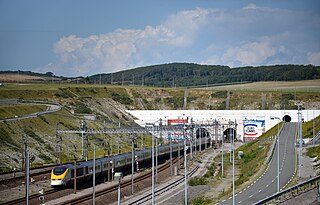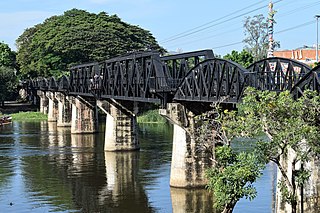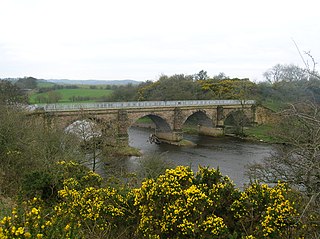
The Channel Tunnel, sometimes referred to as the 'Chunnel', is a 50.46-kilometre (31.35 mi) undersea railway tunnel, opened in 1994, that connects Folkestone with Coquelles beneath the English Channel at the Strait of Dover. It is the only fixed link between the island of Great Britain and the European mainland. At its lowest point, it is 75 metres (246 ft) below the sea bed and 115 metres (377 ft) below sea level. At 37.9 kilometres (23.5 mi), it has the longest underwater section of any tunnel in the world and is the third-longest railway tunnel in the world. The speed limit for trains through the tunnel is 160 kilometres per hour (99 mph). The tunnel is owned and operated by Getlink, formerly Groupe Eurotunnel.

The Burma Railway, also known as the Siam–Burma Railway, Thai–Burma Railway and similar names, or as the Death Railway, is a 415 km (258 mi) railway between Ban Pong, Thailand, and Thanbyuzayat, Burma. It was built from 1940 to 1943 by civilian laborers impressed or recruited by the Japanese and prisoners of war taken by the Japanese, to supply troops and weapons in the Burma campaign of World War II. It completed the rail link between Bangkok, Thailand, and Rangoon, Burma. The name used by the Japanese Government was Tai–Men Rensetsu Tetsudō (泰緬連接鉄道), which means Thailand-Burma-Link-Railway.

A tunnel is an underground or undersea passageway. It is dug through surrounding soil, earth or rock, or laid under water, and is enclosed except for the entrance and exit, commonly at each end. A pipeline is not a tunnel, though some recent tunnels have used immersed tube construction techniques rather than traditional tunnel boring methods.

A viaduct is a specific type of bridge that consists of a series of arches, piers or columns supporting a long elevated railway or road. Typically a viaduct connects two points of roughly equal elevation, allowing direct overpass across a wide valley, road, river, or other low-lying terrain features and obstacles. The term viaduct is derived from the Latin via meaning "road", and ducere meaning "to lead". It is a 19th-century derivation from an analogy with ancient Roman aqueducts. Like the Roman aqueducts, many early viaducts comprised a series of arches of roughly equal length.
The Trans-Asian Railway(TAR) is a project to create an integrated freight railway network across Europe and Asia. The project is of the United Nations Economic and Social Commission for Asia and the Pacific (UNESCAP).

The State Railway of Thailand (SRT) is the state-owned rail operator under the jurisdiction of the Ministry of Transport in Thailand.

The Jammu–Baramulla line is a railway track being laid to connect the Kashmir Valley in the Indian union territory of Jammu and Kashmir with Jammu railway station and thence to the rest of the country. The 338 km railway track will start from Jammu and end at Baramulla. It comes under the jurisdiction of the Firozpur railway division of Indian Railways' Northern zone. Part of this railway route from Udhampur to Baramulla is known as Udhampur-Srinagar-Baramula Rail Link (USBRL). The 359 m (1,178 ft) tall Chenab Bridge lies on this line, which is the tallest railway bridge in the world. The total project cost in 2022 was INR28,000 crore.

Rail transport plays a crucial role in connecting various regions of Thailand, transporting both goods and passengers through a range of transportation options that include inter-city and commuter rail, mass rapid transit, monorails, and airport rail links. The State Railway of Thailand (SRT) operates a network of intercity railways spanning 4,845.1 kilometers, covering 47 provinces across the country. SRT is committed to developing railway lands through its subsidiary, SRT Asset (SRTA), which focuses on transit-oriented development (TOD) initiatives. The Krung Thep Aphiwat Central Terminal in Bangkok serves as the primary transportation hub for rail transport in Thailand, connecting various types of rail transportation throughout the country. It covers an area of 274,192 square meters, making it the largest railway station in Southeast Asia, and is situated in a new central business district (CBD) that is currently being developed.
The Ministry of Development of North Eastern Region is a Government of India ministry, established in September 2001, which functions as the nodal Department of the Central Government to deal with matters related to the socio-economic development of the eight States of Northeast India: Arunachal Pradesh, Assam, Manipur, Meghalaya, Mizoram, Nagaland, Tripura and Sikkim. It acts as a facilitator between the Central Ministries/ Departments and the State Governments of the North Eastern Region in the economic development including removal of infrastructural bottlenecks, provision of basic minimum services, creating an environment for private investment and to remove impediments to lasting peace and security in the North Eastern Region.

Khun Tan Tunnel is a long tunnel under the Khun Tan Range. It is the longest of Thailand's seven railway tunnels.

Hua Lamphong station is a rapid transit station on the Blue Line of the Bangkok MRT. It is located underground on Rama IV Road in front of Bangkok railway station, more commonly known locally as "Hua Lamphong", on the former location of Hua Lamphong railway station, the origin of Paknam Railway, the first railway line in Thailand.

The Khun Tan Range is a mountain range that occupies a central position in Northern Thailand. Most of the range is located in Chiang Mai, western Chiang Rai, Lampang and Lamphun Provinces.

Bang Bamru station is a railway station located at Bang Phlat Subdistrict, Bang Phlat District, Bangkok. It is a class 1 station and serves two systems operated by the State Railway of Thailand, Southern Line and the SRT Light Red Line. It is located 17.94 kilometres (11.1 mi) from Bangkok railway station.

The Northern Line is a railway line in Thailand, running between the capital Bangkok and the northern city of Chiang Mai. It is the second longest railway line in Thailand at 751 kilometres (467 mi) long, has 130 operational stations and halts, and is operated by the State Railway of Thailand. The line first opened in 1896. Major cities served by the line include Bangkok, Ayutthaya, Nakhon Sawan, Phitsanulok, Lampang, and Chiang Mai.

Den Chai station is a railway station located in Den Chai Subdistrict, Den Chai District, Phrae. It is a Class 1 railway station and is the main station for Phrae Province, as there is no rail service to Phrae City. It is located about 530 kilometres (330 mi) from Bangkok railway station. It is also the station to alight for passengers heading to Nan Province.

Eastern Line is a railway line in Thailand, built and owned by State Railway of Thailand (SRT), located in Bangkok, Chachoengsao Province, Nakhon Nayok Province, Saraburi Province, Prachinburi Province, Sa Kaeo Province, Chonburi Province, and Rayong Province. It is the most important freight transport line in Thailand because there are many freight trains on the line. It was opened on 24 January 1907.

Khun Tan railway station is a railway station on the Northern Line located in Lamphun Province, Thailand. It is operated by the State Railway of Thailand, and is 683.14 km (424.5 mi) from Bangkok railway station. Khun Tan Railway Station is in the Tha Pladuk Subdistrict, Mae Tha District.
Chong Khao station is a railway station located in Tham Yai Subdistrict, Thung Song District, Nakhon Si Thammarat. It is a class 3 railway station located 767.786 km (477.1 mi) from Thon Buri railway station. It is located adjacent to the Chong Khao Tunnel.

The Boten–Vientiane railway is the Lao section of the Laos–China Railway (LCR), running between the capital Vientiane and the northern town of Boten on the border with Yunnan, China. The line was officially opened on 3 December 2021.

The Bangkok–Nong Khai high-speed railway or Northeastern high-speed rail line is a high-speed railway under construction in Thailand. It will be the first high-speed line in Thailand. It will be constructed in multiple phases; the first phase, between Bangkok and Nakhon Ratchasima, is expected to open in 2026 after multiple delays. The rest of the line to Nong Khai and across the Mekong River to Vientiane, Laos is expected to be operational by 2028.






















